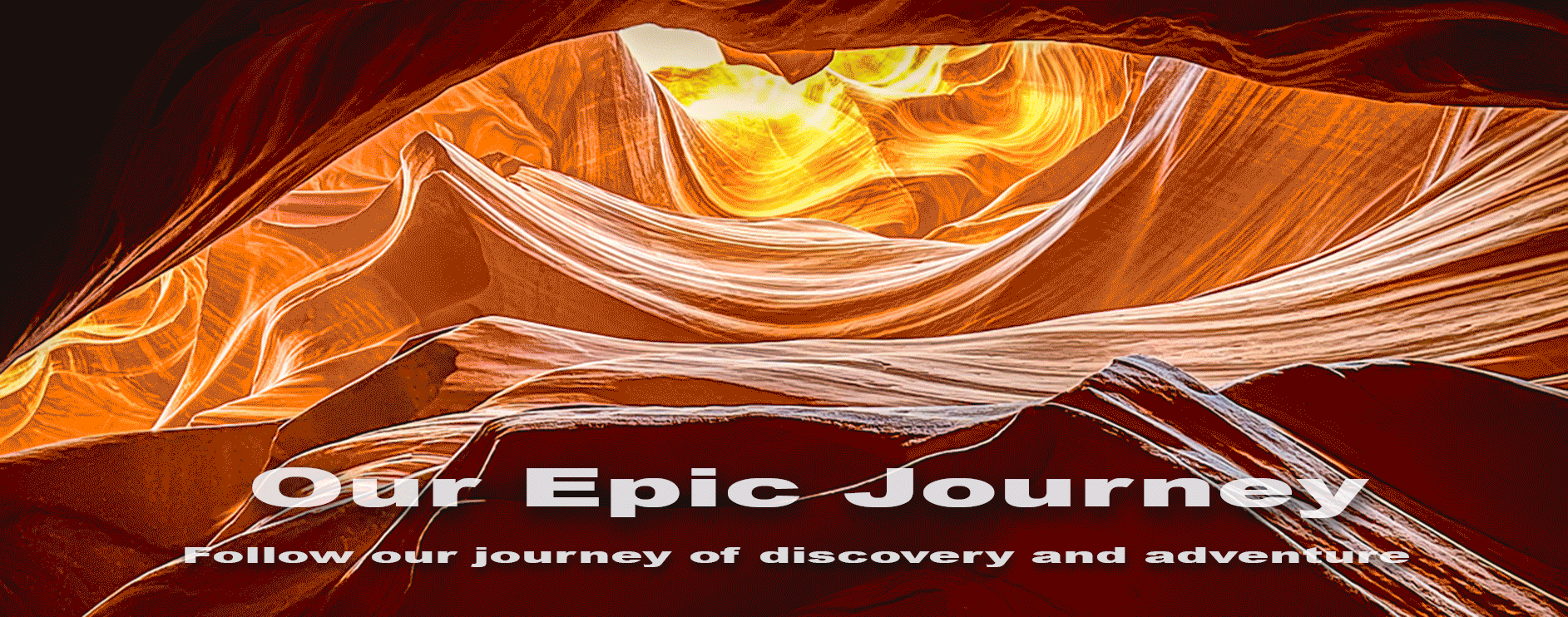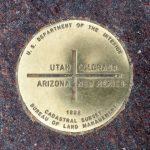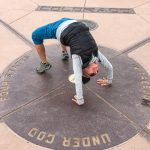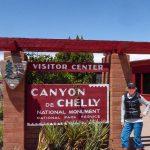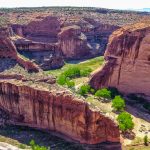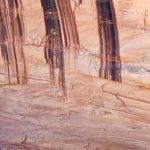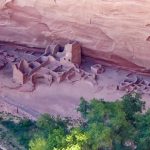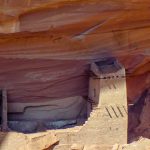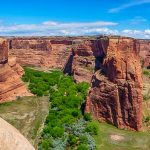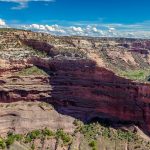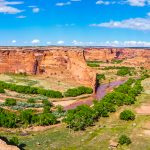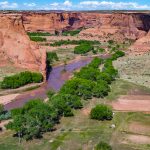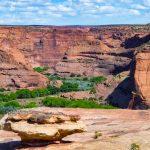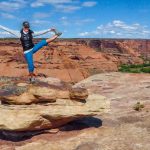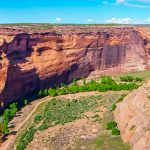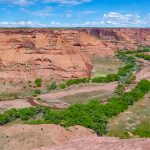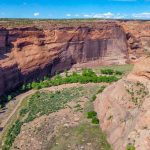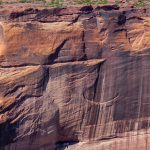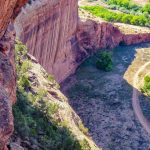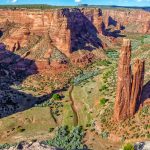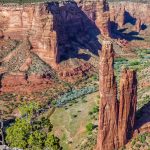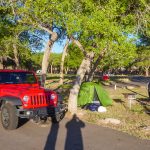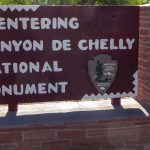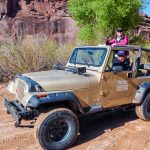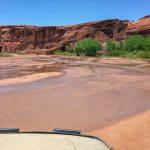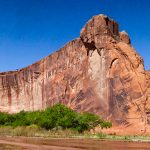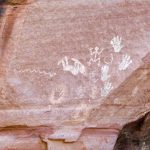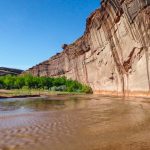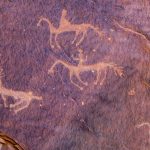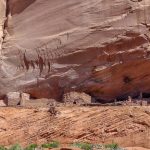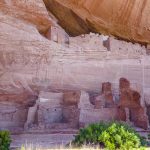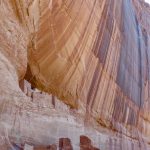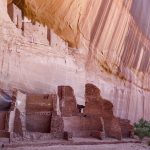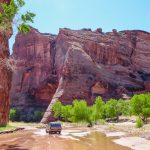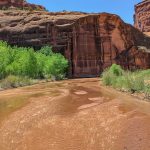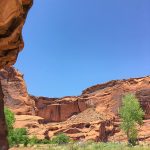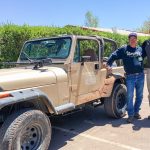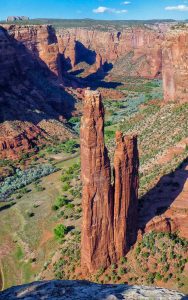
We packed up all our camping gear in the back of the jeep and left to drive the 3 hours to Canyon De Chelly in Arizona and camp there one night. On the way we stopped at the Four Corners Monument in Arizona, which marks the quadripoint where the states of Arizona, Colorado, New Mexico and Utah meet. The Navajo Nation maintains the monument as a tourist attraction, and it cost $10 to enter, there is nothing to do there except wait in line to get your picture taken on all four states, or buy from the Navajo vendors set up around the monument. It wasn’t very busy so we were able to get in and out fairly quickly.
We arrived at the small town of Chinle, AZ, and went to the Visitor Center first to find out where to go and what to see here. Canyon De Chelly National Monument, established in 1931, includes two large canyons, Canyon de Chelly, (pronounced “d’shay”) to the south and Canyon Del Muerto to the north. Canyon de Chelly got its name from the Navajo word Tseyi, which means canyon or “in the rock.” Canyon Del Muerto, Spanish for “canyon of the dead,” was named when remains of mummies were discovered on an archeological expedition in the 1880s. Canyon de Chelly is entirely owned by the Navajo Tribal Trust of the Navajo Nation, and approximately 40 Navajo families live in the park. We decided to do the North Rim Drive first and walked to the overlook of the Antelope House Ruins. We were in awe as we viewed the canyon from the overlook and its 1000 feet walls of red, black and orange. The Antelope House ruins were nestled on the canyon floor under an alcove. We used our binoculars to see the ruins up close.
Next we stopped at the Navajo Fortress Viewpoint; where we could see the Navajo Fortress, an isolated high red stone butte located across the canyon. It was used as a refuge throughout the period of Spanish and American military actions against the Navajo people. There is a trail leading to the top of the fortress from the canyon floor, and the log poles that were used to connect the lower levels with inaccessible sections directly above still stand. We stopped at two more overlooks, the Mummy Cave and the Massacre Cave, named after historic Navajo stories that happened during their occupation of this region. Then we went to the South Rim Drive, where we saw the White House Overlook. Across the canyon from the overlook we saw the ruins of a village constructed in two sections the cliff dwellings in the alcove and the masonry pueblo on the canyon floor. This is the only ruins that you can walk down to explore without a guide. We continued on our drive to the Sliding House Overlook, where you could see the ruins on the narrow ledge across the canyon. The Pueblo people had to build retaining walls to keep their home from sliding into the canyon. Click on thumbnail to view images
We saved the best for last, Spider Rock Overlook, we got there when the sun was low in the sky and the Rock was in full light. The floor of the canyon is about 1,000 feet below, and Spider Rock is the most prominent landmark in the area, at 800 feet tall, it stands at the junction of two canyons, Monument Canyon and Canyon de Chelly. On the horizon above Spider Rock we saw the prominent peak of Black Rock, a volcanic plug, 70 millions years old. The Navajo believe that Spider Woman, the deity who taught the Navajo woman how to weave, lives atop Spider Rock. According to Navajo oral history, Face Rock, the pinnacle facing Spider Rock, reports the names of misbehaving children to Spider Woman, and she carries the naughty children to the top of Spider Rock. And that’s how it got its name! We completed the tour of the North and South Rim Overlooks, and it was time to find a campsite. We went to the Cottonwood Campground near the Visitor Center and checked in for one night, $14 fee.
Jeep Tour of the Canyon
Today is the day to see the canyon from the floor. I had contacted the Canyon Ancient Jeep Tours and spoke to Oscar Bia, who is going to be our Navajo guide to take us through the canyon. We met him at 9am, driving a 1992 jeep with no roof, we could view the canyon without any obstructions. Oscar grew up in Canyon de Chelly and knows a lot of the Navajo history, he is a Shaman and a Medicine Man and is very knowledgeable of the many long and intricate ceremonies of the Dine(meaning “The People” the true name for the Navajo). There is no road into the canyon, he drove up the river bed with still quite a lot of water in some places. We stopped to view more ruins that we could not see from the rim, while Oscar shared his knowledge of Navajo history, and rock art interpretation. We went up Canyon de Chelly as far as the White House ruins, this is one of the most dramatic ruins in the canyon. There were several Navajo vendors selling their goods, and I was very impressed by their jewelry and ceramic pottery, too bad I didn’t have enough cash to buy anything. Click on thumbnail to view images
Then we turned back to go up Canyon Del Muerto to Antelope House ruins, driving along the bumpy river bed with amazing views of the sheer cliffs above was unforgettable. Oscar is a wonderful guide, he made the history and lore of the Canyon de Chelly and the Navajo people come alive. On our way back he pointed out the trail up to the Navajo Fortress, that he climbed up when he was younger, and we could see the ladders that he climbed on to get to the top. What a wonderful experience and I would highly recommend a jeep tour with Oscar Bia.

On our way back to the RV Park we wanted to go by Shiprock in New Mexico, because we had seen it in the distance from Mesa Verde. Shiprock, (Navajo for “rock with wings” or “winged rock”) is a monadnock, an erosional remnant of the throat of a volcano, rising nearly 1,583 feet above the high-desert plain of the Navajo Nation. It is quite an amazing sight and I am glad we drove this way to see it close up.
